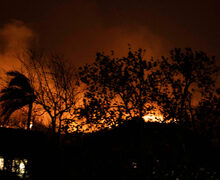Helen Zughaib’s ArtRage exhibit is a celebration of family strength
Lars Jendruschewitz | Assistant Photo Editor
Using gouache, a light watercolor and ink on canvas, Helen Zughaib shares stories her father told her. The exhibit, “Stories My Father Told Me: Memories of a Childhood in Syria and Lebanon,” is on display at ArtRage, a gallery in Syracuse.
Get the latest Syracuse news delivered right to your inbox.
Subscribe to our newsletter here.
While many view the War on terror as a source of fear, Helen Zughaib saw it as a way to have her voice heard. Through multiple collections of art, Zughaib showed her history and righted the world with her beautiful, yet poignant pieces.
“With 9/11 we ended up of course, as you know, a lot of anti-Arab sentiments in the news and the media so on so forth, and as artists, our voice and someone trying to combat that the only way really know how,” Zughaib said in her Artist Talk on Wednesday, Oct. 4.
ArtRage Gallery, a local art gallery in Syracuse, is known for displaying art from underrepresented artists. This exhibit is titled “Stories My Father Told Me: Memories of a Childhood in Syria and Lebanon.” Each work is gouache, a light watercolor and ink on canvas. These bright works are accompanied by a recollection of her father’s childhood. The gallery begins with a painting of Zughaib’s father telling her these stories and ends with their family leaving for the United States.
Zughaib’s work is far from unknown. Her work has been displayed in notable locations such as the Congressional Library and U.S. Embassies and was gifted to world leaders by former President Barack Obama.
Although her work has gone far and wide, Zughaib was born in Beirut, Lebanon, having fled from the Lebanese Civil War in the 1980s. She was told she’d come back in one week at the time of her departure but didn’t return home until 35 years later.
Due to the nature of her departure from Lebanon, much of her work emphasizes shoes.
“For me, shoes represent two things. They represent writing to your dreams and running from danger. So I think that is the duality that chooses to hold,” Zughaib said.
The shoes have a personal meaning to Zughaib as well. When her family was fleeing from Lebanon, her sister dropped her shoe. Being an older sibling, she was faced with the decision to either retrieve the shoe or continue running as she was supposed to. She never revealed which choice she made.

Lars Jendruschewitz | Assistant Photo Editor
The ArtRage Gallery aims to display art from underrepresented artists. “Stories My Father Told Me: Memories of a Childhood in Syria and Lebanon,” an exhibit by Helen Zughaib, tells her story through bright color.
Lars Jendruschewitz | Assistant Photo Editor
Kimberley McCoy, an organizer for this exhibit, believes Zughaib speaks to the Syracuse community. Zughaib has many ties to the city since she graduated from the College of Visual and Performing Arts and has family in the area.
“This exhibition is very personal for her,” McCoy said. “Helen’s work overall talks a lot about the Arab world and tries to break down stereotypes, and just be a bridge for cultural understanding and acceptance.”
Many of the attendees to Zughaib’s artist talk were characters in her personal life, with family, friends, colleagues and fans all in the audience. Pam McLaughlin, a board member at ArtRage and someone who’s worked with gouache herself, was amazed by Zughaib’s work, both through the artistry of the painting and the meaning.
“(The artwork) shows such a beautiful life, we’re no different, there’s a family, there’s a story, there’s struggle, there’s having babies, there’s going on picnics, there’s travel, there’s going to a different place, there’s rituals that continue the culture forward,” McLaughlin said. “It’s humanizing.”
Outside of her artwork, Zughaib also works with multiple federal agencies aiding refugees. Recently, she worked with the State Department to aid refugees in Switzerland. She primarily helps refugees produce art of their own histories, emphasizing the importance of their stories.
“This guy comes up to me from Libya. He had been on (refugee boat) and he survived,” Zughaib said. “I said, ‘Where were you sitting? Do you remember where?’ He said ‘I can never forget where I was sitting.’ So he told me he wanted to give (his drawing) to me. I said ‘no, this is your history. This is for you.’”
Published on October 11, 2023 at 10:58 pm






